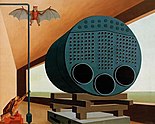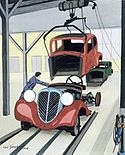Carl Grossberg
You can help expand this article with text translated from the corresponding article in German. (September 2016) Click [show] for important translation instructions.
|

Carl Grossberg (6 September 1894 – 9 October 1940) was a German painter associated with the New Objectivity movement.
Biography
Grossberg was born in Elberfeld and studied architecture in Aachen and Darmstadt prior to his military service in World War I. He later studied at the Weimar Academy of Art and from 1919-1921 he studied at the Bauhaus under Lyonel Feininger. He became known for paintings of urban landscapes, and for exterior and interior views of factories and industrial sites which he rendered with a chilly precision.
In 1926 Grossberg had his first solo exhibition in Stuttgart. In 1929 he took part in the exhibition Neue Sachlichkeit in the Stedelijk Museum in Amsterdam. Two years later he won the Prix de Rome of the Preußischer Akademie der Künste. In 1934 he was commissioned to paint a wall painting called Deutsches Volk, deutsche Arbeit.
He served in the military again in 1939–1940 in France, where he died in a car crash in Laon.
Selected paintings
-
Creglingen, 1926
-
Steam Boiler with Bat, 1928
-
Composition with Turbine, 1929
-
Automobile fabrication, 1936
References
- Michalski, Sergiusz (1994). New Objectivity. Cologne: Benedikt Taschen. ISBN 3-8228-9650-0
- Schmied, Wieland (1978). Neue Sachlichkeit and German Realism of the Twenties. London: Arts Council of Great Britain. ISBN 0-7287-0184-7
- Ingo F. Walher (red.) Kunst in de 20e eeuw. Deel II. Bijlage: Biografieën. Taschen, Cologne 2005
External links
![]() Media related to Carl Grossberg at Wikimedia Commons
Media related to Carl Grossberg at Wikimedia Commons




